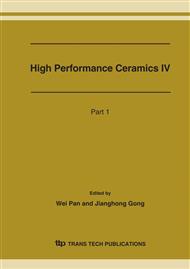p.826
p.831
p.834
p.838
p.842
p.846
p.850
p.854
p.857
High Temperature Thermoelectric Property of Sr-Filled Skutterudite SryCo4Sb12
Abstract:
Sr-filled skutterudite compounds SryCo4Sb12 (y=0-0.20) were synthesized by melting method. XRD and EPMA results revealed that the obtained samples are single skutterudite phase with homogeneous chemical composition. The lattice parameters increase linearly with increasing Sr content in the range of y=0-0.20. The thermal conductivity, electrical conductivity and Seebeck coefficient were measured in the temperature range of 300-850K. The measurement of Hall effect was performed by Van de Pauw method at room temperature. The obtained Sr-filled skutterudite exhibits n-type conduction. The absolute value of the Seebeck coefficient of SryCo4Sb12 decreases with the increase of Sr content. The electrical conductivity increases with the increase of Sr content. The lattice thermal conductivity of SryCo4Sb12 is significantly depressed as compared with unfilled CoSb3. The maximum dimensionless thermoelectric figure of merit is 0.7 for Sr0.20Co4Sb12 at 850K. Further optimization of chemical composition would improve the thermoelectric performance.
Info:
Periodical:
Pages:
842-845
Citation:
Online since:
April 2007
Authors:
Keywords:
Price:
Сopyright:
© 2007 Trans Tech Publications Ltd. All Rights Reserved
Share:
Citation:


